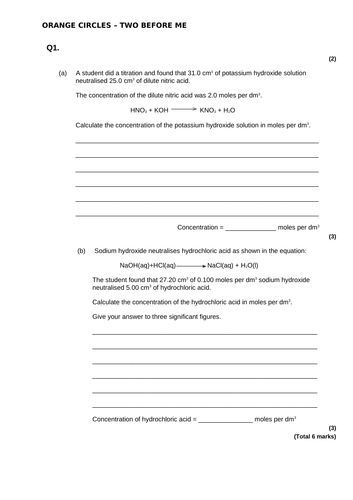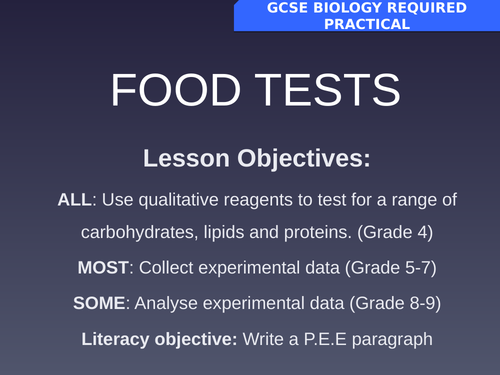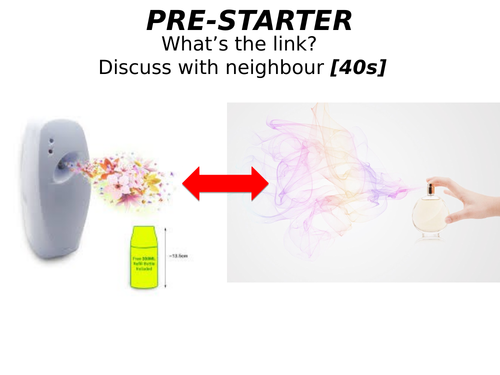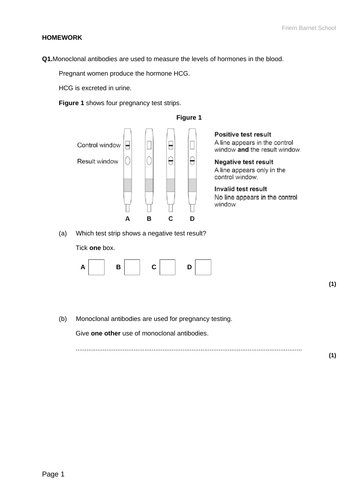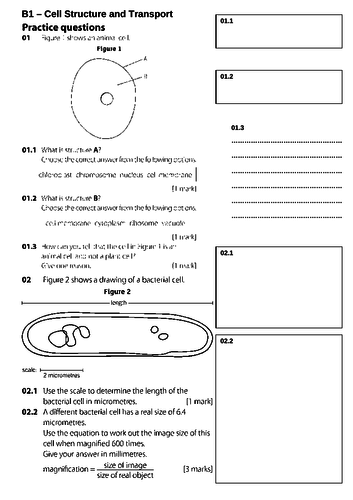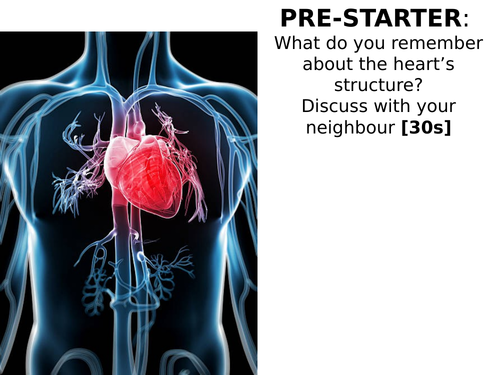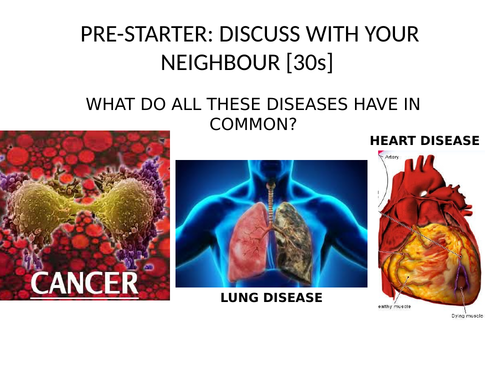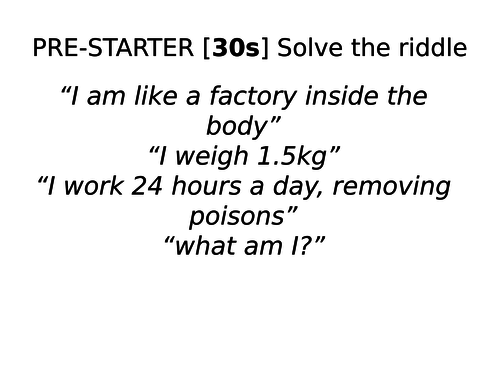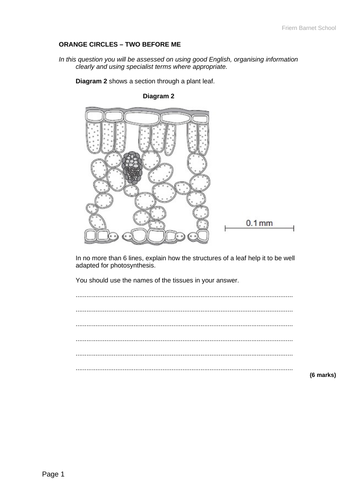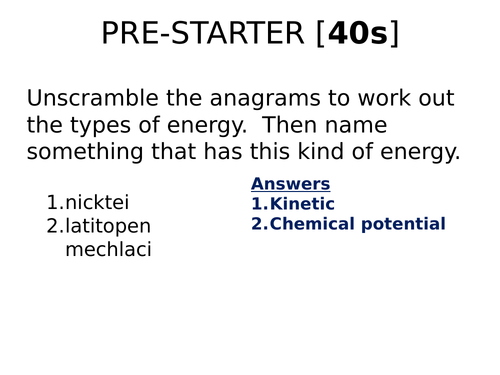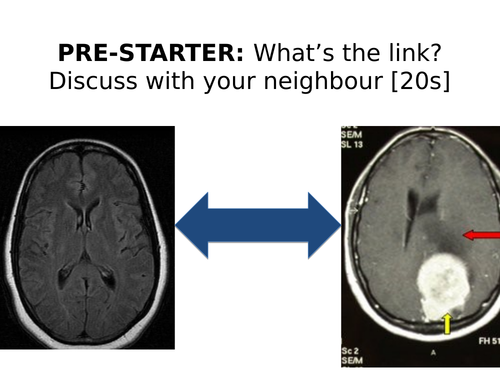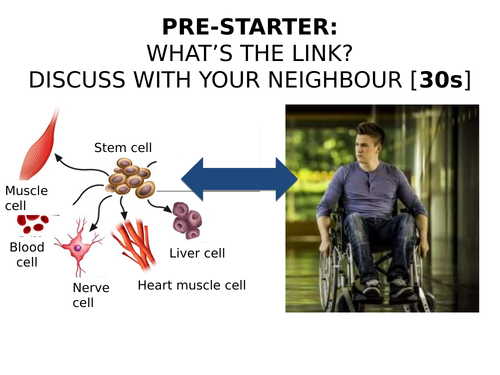172Uploads
30k+Views
2k+Downloads
Featured resources

2018 AQA GCSE Chemistry Unit 1 (C1): Quantitative Chemistry - Titration Calculations L9
This is the lesson used to teach Titration Calculations in accordance with the new 2018 AQA GCSE specification for Combined Science: Trilogy and GCSE Chemistry.
This high quality lesson has the following features:
Lessons have Bloom’s Taxonomy embedded throughout which are also graded for differentiation.
Stretch and challenge tasks throughout (including Grade 8-9+ questions and extended writing)
AfL (3 progress checks per lesson embedded)
Differentiation is strong as has been noted in all formal school observations for the last 2 years of teaching AQA. Observations of these lessons has always evidenced that these lessons are consistently of a ‘good’ OFSTED standard.
Narrative of lesson structure is clear and focused as well as engaging.
Pre-starter prepared.
All lessons are geared with top-down approach pedagogy and provide inclusive differentiation for low attaining and medium attaining pupils as well.
In order to take full advantage of this resource, it should be ‘tweaked’ to the needs of your own pupils.

2018 AQA GCSE Biology Unit 1 (B1): Food tests Required Practical
This pack contains all resources needed to deliver the Food Tests Required Practical for new 2018 AQA GCSE Biology and Combined Science: Trilogy specfications.

2018 AQA GCSE Biology Unit 1 (B1): Diffusion L6
This lesson is for teaching the above named lesson as part of the Cell Biology module of Biology Unit 1 (B1) of the new 2018 AQA GCSE specifications for Combined Science: Trilogy and GCSE Biology.
The lesson has the following features embedded:
Lesson has Bloom’s Taxonomy embedded throughout which are also graded for differentiation.
Stretch and challenge tasks throughout (including Grade 8-9+ questions and extended writing)
AfL (3 progress checks embedded)
Differentiation is strong as has been noted in all formal school observations for the last 2 years of teaching AQA.
Narrative of lesson structure is clear and focused as well as engaging.
Pre-starter prepared.
The lesson is geared with top-down approach pedagogy and provide inclusive differentiation for low attaining and medium attaining pupils as well.
The lesson should be ‘tweaked’ to meet the needs of your own pupils.

2018 AQA GCSE Biology Unit 1 (B1): Monoclonal Antibodies L26
This lesson is for teaching the above named lesson as part of the Infection and Response module of Biology Unit 1 (B1) of the new 2018 AQA GCSE specifications for Combined Science: Trilogy and GCSE Biology.
The lesson has the following features embedded:
Lesson has Bloom’s Taxonomy embedded throughout which are also graded for differentiation.
Stretch and challenge tasks throughout (including Grade 8-9+ questions and extended writing)
AfL (3 progress checks embedded)
Differentiation is strong as has been noted in formal school observations for the last 2 years of teaching AQA.
Narrative of lesson structure is clear and focused as well as engaging.
Pre-starter prepared.
The lesson is geared with top-down approach pedagogy and provide inclusive differentiation for low attaining and medium attaining pupils as well.
The lesson should be ‘tweaked’ to meet the needs of your own pupils.

AQA GCSE Physics Unit 1 (P1): Energy Module - Power and Work Done L4
This lesson is for teaching the above named lesson as part of the Energy Module of Physics Unit 1 (P1) of the new 2018 AQA GCSE specification for GCSE Physics.
The lesson has the following features embedded:
Lesson has Bloom’s Taxonomy embedded throughout which are also graded for differentiation.
Stretch and challenge
AfL (progress checks embedded)
Narrative of lesson structure is clear and focused as well as engaging.
Pre-starter prepared.
The lesson is geared with top-down approach pedagogy and provide inclusive differentiation for low attaining and medium attaining pupils as well.
The lesson should be ‘tweaked’ to meet the needs of your own pupils.

AQA GCSE Physics Unit 1 (P1): Energy Module - Specific Heat Capacity Theory - L6
This lesson is for teaching the above named lesson as part of the Energy Module of Physics Unit 1 (P1) of the new 2018 AQA GCSE specification for GCSE Physics.
The lesson has the following features embedded:
Lesson has Bloom’s Taxonomy embedded throughout which are also graded for differentiation.
Stretch and challenge
AfL (progress checks embedded)
Narrative of lesson structure is clear and focused as well as engaging.
Pre-starter prepared.
The lesson is geared with top-down approach pedagogy and provide inclusive differentiation for low attaining and medium attaining pupils as well.
The lesson should be ‘tweaked’ to meet the needs of your own pupils.

2018 AQA GCSE Biology Unit 1 (B1): Cell Structure and Transport Exam Questions
Cell Structure and Transport Exam Questions Pack. With lots of extended writing style questions as well. Enjoy.

2018 AQA GCSE Biology Unit 1 (B1): Lung Structure and Function
This lesson is for teaching the above named lesson as part of the Organisation module of Biology Unit 1 (B1) of the new 2018 AQA GCSE specifications for Combined Science: Trilogy and GCSE Biology.
The lesson has the following features embedded:
Lesson has Bloom’s Taxonomy embedded throughout which are also graded for differentiation.
Stretch and challenge tasks throughout (including Grade 8-9+ questions and extended writing)
AfL (3 progress checks embedded)
Differentiation is strong as has been noted in all formal school observations for the last 2 years of teaching AQA.
Narrative of lesson structure is clear and focused as well as engaging.
Pre-starter prepared.
The lesson is geared with top-down approach pedagogy and provide inclusive differentiation for low attaining and medium attaining pupils as well.
The lesson should be ‘tweaked’ to meet the needs of your own pupils.

AQA GCSE Physics Unit 1 (P1): Electricity Module - Electrical Charge and Flow L3
This lesson is for teaching the above named lesson as part of the Electricity Module of Physics Unit 1 (P1) of the new 2018 AQA GCSE specification for GCSE Physics.
The lesson has the following features embedded:
Lesson has Bloom’s Taxonomy embedded throughout which are also graded for differentiation.
Stretch and challenge
AfL (progress checks embedded)
Narrative of lesson structure is clear and focused as well as engaging.
Pre-starter prepared.
The lesson is geared with top-down approach pedagogy and provide inclusive differentiation for low attaining and medium attaining pupils as well.
The lesson should be ‘tweaked’ to meet the needs of your own pupils.

AQA GCSE Physics Unit 1 (P1): Energy Module - full lesson pack (Trilogy and Triple Science Lessons)
This lesson pack is for teaching the above named module Energy of Physics Unit 1 (P1) of the new 2018 AQA GCSE specification for GCSE Physics.
The lessons have the following features embedded:
Lesson has Bloom’s Taxonomy embedded throughout which are also graded for differentiation.
Stretch and challenge
AfL (progress checks embedded)
Narrative of lesson structure is clear and focused as well as engaging.
Pre-starter prepared.
The lesson is geared with top-down approach pedagogy and provide inclusive differentiation for low attaining and medium attaining pupils as well.
The lesson should be ‘tweaked’ to meet the needs of your own pupils.
This module pack is offered at a discount rate to buying all the module lessons individually.

2018 AQA GCSE Biology Unit 1 (B1): Non-Communicable Diseases L16
This lesson is for teaching the above named lesson as part of the Organisation module of Biology Unit 1 (B1) of the new 2018 AQA GCSE specifications for Combined Science: Trilogy and GCSE Biology.
The lesson has the following features embedded:
Lesson has Bloom’s Taxonomy embedded throughout which are also graded for differentiation.
Stretch and challenge tasks throughout (including Grade 8-9+ questions and extended writing)
AfL (3 progress checks embedded)
Differentiation is strong as has been noted in all formal school observations for the last 2 years of teaching AQA.
Narrative of lesson structure is clear and focused as well as engaging.
Pre-starter prepared.
The lesson is geared with top-down approach pedagogy and provide inclusive differentiation for low attaining and medium attaining pupils as well.
The lesson should be ‘tweaked’ to meet the needs of your own pupils.

2018 AQA GCSE Biology Unit 1 (B1): Metabolism and the Liver L32
This lesson is for teaching the above named lesson as part of the Bioenergetics module of Biology Unit 1 (B1) of the new 2018 AQA GCSE specifications for Combined Science: Trilogy and GCSE Biology.
The lesson has the following features embedded:
Lesson has Bloom’s Taxonomy embedded throughout which are also graded for differentiation.
Stretch and challenge tasks throughout (including Grade 8-9+ questions and extended writing)
AfL (3 progress checks embedded)
Differentiation is strong as has been noted in formal school observations for the last 2 years of teaching AQA.
Narrative of lesson structure is clear and focused as well as engaging.
Pre-starter prepared.
The lesson is geared with top-down approach pedagogy and provide inclusive differentiation for low attaining and medium attaining pupils as well.
The lesson should be ‘tweaked’ to meet the needs of your own pupils.

AQA GCSE Physics Unit 2 (P2): Forces Module - Scalar and Vector Quantities L1
This lesson is for teaching the above named lesson as part of the Forces Module of Physics Unit 1 (P2) of the new 2018 AQA GCSE specification for GCSE Physics.
The lesson has the following features embedded:
Lesson has Bloom’s Taxonomy embedded throughout which are also graded for differentiation.
Stretch and challenge
AfL (progress checks embedded)
Narrative of lesson structure is clear and focused as well as engaging.
Pre-starter prepared.
The lesson is geared with top-down approach pedagogy and provide inclusive differentiation for low attaining and medium attaining pupils as well.
The lesson should be ‘tweaked’ to meet the needs of your own pupils.

AQA GCSE Physics Unit 2 (P2): Forces Module - Moments at Work L8
This lesson is for teaching the above named lesson as part of the Forces Module of Physics Unit 2 (P2) of the new 2018 AQA GCSE specification for GCSE Physics.
The lesson has the following features embedded:
Lesson has Bloom’s Taxonomy embedded throughout which are also graded for differentiation.
Stretch and challenge
AfL (progress checks embedded)
Narrative of lesson structure is clear and focused as well as engaging.
Pre-starter prepared.
The lesson is geared with top-down approach pedagogy and provide inclusive differentiation for low attaining and medium attaining pupils as well.
The lesson should be ‘tweaked’ to meet the needs of your own pupils.

2018 AQA GCSE Biology Unit 1 (B1): Transport in Plants Part 1 L18
This lesson is for teaching the above named lesson as part of the Organisation module of Biology Unit 1 (B1) of the new 2018 AQA GCSE specifications for Combined Science: Trilogy and GCSE Biology.
The lesson has the following features embedded:
Lesson has Bloom’s Taxonomy embedded throughout which are also graded for differentiation.
Stretch and challenge tasks throughout (including Grade 8-9+ questions and extended writing)
AfL (3 progress checks embedded)
Differentiation is strong as has been noted in all formal school observations for the last 2 years of teaching AQA.
Narrative of lesson structure is clear and focused as well as engaging.
Pre-starter prepared.
The lesson is geared with top-down approach pedagogy and provide inclusive differentiation for low attaining and medium attaining pupils as well.
The lesson should be ‘tweaked’ to meet the needs of your own pupils.

2018 AQA GCSE Physics Unit 1 (P1): Efficiency L9
This lesson is for teaching the above named lesson as part of the Energy module of Physics Unit 1 (P1) of the new 2018 AQA GCSE specifications for Combined Science: Trilogy and GCSE Physics.
The lesson has the following features embedded:
Lesson has Bloom’s Taxonomy embedded throughout which are also graded for differentiation.
Stretch and challenge tasks throughout (including Grade 8-9+ questions and extended writing)
AfL (3 progress checks embedded)
Differentiation is strong as has been noted in formal school observations for the last 2 years of teaching AQA.
Narrative of lesson structure is clear and focused as well as engaging.
Pre-starter prepared.
The lesson is geared with top-down approach pedagogy and provide inclusive differentiation for low attaining and medium attaining pupils as well.
The lesson should be ‘tweaked’ to meet the needs of your own pupils.

AQA GCSE Physics Unit 1 (P1): Energy Module - Gravitational Potential Energy L3
This lesson is for teaching the above named lesson as part of the Energy Module of Physics Unit 1 (P1) of the new 2018 AQA GCSE specification for GCSE Physics.
The lesson has the following features embedded:
Lesson has Bloom’s Taxonomy embedded throughout which are also graded for differentiation.
Stretch and challenge
AfL (progress checks embedded)
Narrative of lesson structure is clear and focused as well as engaging.
Pre-starter prepared.
The lesson is geared with top-down approach pedagogy and provide inclusive differentiation for low attaining and medium attaining pupils as well.
The lesson should be ‘tweaked’ to meet the needs of your own pupils.

2018 AQA GCSE Biology Unit 1 (B1): Cancer L17
This lesson is for teaching the above named lesson as part of the Organisation module of Biology Unit 1 (B1) of the new 2018 AQA GCSE specifications for Combined Science: Trilogy and GCSE Biology.
The lesson has the following features embedded:
Lesson has Bloom’s Taxonomy embedded throughout which are also graded for differentiation.
Stretch and challenge tasks throughout (including Grade 8-9+ questions and extended writing)
AfL (3 progress checks embedded)
Differentiation is strong as has been noted in all formal school observations for the last 2 years of teaching AQA.
Narrative of lesson structure is clear and focused as well as engaging.
Pre-starter prepared.
The lesson is geared with top-down approach pedagogy and provide inclusive differentiation for low attaining and medium attaining pupils as well.
The lesson should be ‘tweaked’ to meet the needs of your own pupils.

KS3 National Curriculum Exam Question Packs for Working Scientifically - with Mark Schemes
This high quality pack contains very large exam question packs (with mark schemes) ranging from low level to high level challenge suitable for pupils off all set of attainment. There is an exam question pack for each and every topic of KS3 Working Scientifically.

2018 AQA GCSE Biology Unit 1 (B1): Stem Cells L5
This lesson is for teaching the above named lesson as part of the Cell Biology module of Biology Unit 1 (B1) of the new 2018 AQA GCSE specifications for Combined Science: Trilogy and GCSE Biology.
The lesson has the following features embedded:
Lesson has Bloom’s Taxonomy embedded throughout which are also graded for differentiation.
Stretch and challenge tasks throughout (including Grade 8-9+ questions and extended writing)
AfL (3 progress checks embedded)
Differentiation is strong as has been noted in all formal school observations for the last 2 years of teaching AQA.
Narrative of lesson structure is clear and focused as well as engaging.
Pre-starter prepared.
The lesson is geared with top-down approach pedagogy and provide inclusive differentiation for low attaining and medium attaining pupils as well.
The lesson should be ‘tweaked’ to meet the needs of your own pupils.


